The Best 5-Channel Amplifiers
What is the best 5-Channel amp on the market? There’s no straightforward answer to that question, because there are many different factors in play for each individual.
Don’t just go with the most expensive car amplifier, either, because that won’t necessarily get you the best product for you. Of course, cost comes into it, but each amp brings something to the table.
I researched some top brands and best-selling products to help you find the best 5-channel amp, but before we get to the reviews, let’s take a closer look at some of the things you need to know.
Getting a 5-Channel Amp – What You Should Know…
You’re keen to get the very best out of your car stereo, and your old amplifier won’t suffice. You’re not sure whether to get a second amp or invest in the best 5-channel amplifier you can afford.
5-channel amps are expensive, compared with the rest of your car stereo system, and it might be cheaper to get a second amp. But there are benefits to spending that bit extra, such as taking up less space, and getting an extremely powerful amplifier that runs your entire car stereo system.
Any amplifier improves the sound quality and volume your car speakers can produce, but not all amps are created equally. And if your system needs more power than your existing amp can manage, should you get a second amp or go for a 5-channel amplifier?
Both are good options, but you have to consider how much space you have if you’re going for a second amp. A 5-channel amp covers all bases, as it can easily power 4 car speakers and a subwoofer, or two.
If you’re looking for the best 5-channel amplifier, read on as I’ve put together a list that I have reviewed and rate on their specifications, performance, and value for money.
There are many more car amplifiers that didn’t make my list that could have quite easily, but I have tried to be as varied as possible, and every amplifier on the list is excellent in its specific niche.
If you prefer to know more about how to choose the right amplifier, check out the Buyer’s Guide which is down below under the reviews…
What is the Best 5-Channel Amp?
Kicker 46CXA660.5 – 5-Channel Full Range Bridgeable Amplifier

Starting the review, I’ve gone with one of the most recognizable brands in the car audio industry, and this Kicker 46CXA660.5 5-channel pushes out some serious power.
Using A/B Class technology for the front and rear channels, and a separate D Class for the subwoofer channel, this amp offers the best possibilities for performance in every range.
With an impressive 4 x 65W RMS output per channel @ 4 ohms, and 300W RMS @ 2 ohms for your subwoofer channel the power this amp delivers is clean and crisp.
And for anyone who really loves the bass low and heavy, KickEQ 6dB variable bass boost allows you to add some low-end punch, and believe me it shakes your vehicle.
You can also bridge this amp to drive a pair of high-performance component speakers with 2 x 180W RMS, and the sub with 300 watts, which will give you unbelievable sounds from the deepest bass to the highest highs.
This is helped by the separate high-pass filters on the front and rear channels, and variable low-pass and a fixed subsonic filter for your bass, which allows you to sculpt the very sound you want.
And to put things within driver’s distance, the amp comes with an optional wired remote, allowing you to conveniently adjust the subwoofer level without getting out of your seat.

Specifications
Class A/B Full-Range Channels and Class D Subwoofer Channel
Power (watts/ch) 4 Ohm Stereo – 65×4
Power (watts/ch) 2 Ohm Stereo – 90×4
Power (watts/ch) 4 Ohm Mono – 180×2
Power (watts/ch) 4 Ohm Mono Sub Ch – 150×1
Power (watts/ch) 2 Ohm Mono Sub Ch – 300×1
Frequency Response (Hz): – 10Hz-20kHz
Frequency Response (Hz – Sub Ch.): – 25Hz-200Hz
Input Sensitivity: – 250mV-10V (Low Level), 1V-40V (High Level)
Signal-to-Noise Ratio: – 90dB
Active Crossover: – Amp 1-2: High Pass 10-200Hz @ 12dB/Octave, Sub Channel: Low Pass 50-200Hz @ 12dB/Octave
Subsonic Filter: – 25Hz @24dB/Octave
KickEQ™ Boost – Variable 0-6dB @40Hz
Alpine X-A90V X-Series – The Best Performing 5-Channel Amp
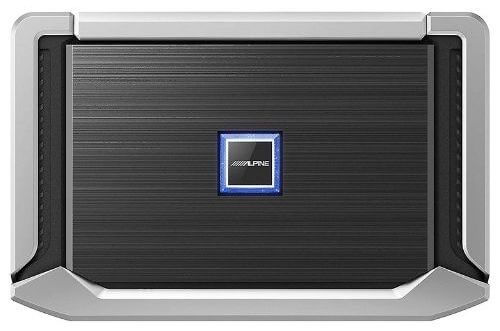
This Alpine X-A90V X Series 5-Channel Amplifier is quite simply a beast. Before reading, I should tell you it’s my most expensive car amp on the list, but if you can afford it, you won’t be disappointed as it performs as well as any amplifier on the market.
The powerhandling for this Class D Alpine amp is decent, but for the price entry it should be. Running at 4 ohms, the RMS of the main 4 channels is 75W, while the sub channel is 300W.
If you want to run your 5-channel car amp at 2 ohms, the RMS is an impressive 100W x4 for the main channels and 500W for your subwoofer channel.
The amplifier is bridgeable, and with the power and dependability of this amplifier, it will allow you to push 2 x high-performance speakers at 200W RMS 4 ohms, driving some volume with extreme clarity, ensuring you enjoy a soundscape like no other.
Alpine’s X-Series amplifiers are built with the new Alpine-proprietary circuit design that achieves class-leading power density and reliability while performing at the top of its class.
The signal it sends to your car speakers is as clear as you can get, and it’s all helped by Alpine’s exclusive dual feedback loop which corrects any signal distortion. This results in a frequency response that not only meets the Hi-Rez audio standard of 40kHz but even extends up to an impressive 60kHz.
This 5-channel amp’s solid cast aluminum heat sink is different to other brand’s. Thanks to the design, any excess heat is removed from the channels – located on both sides of the amp, which allows for continuous airflow. And with the heat rising from the top of the amplifier, it causes a vacuum that sucks in cool air form below, ultimately allowing the Alpine amplifier to perform well for long periods of time.
The S/N is over 105dB, while the THD = 0.07%, added with the variable high and low pass filters, the subsonic filter, and variable bass boost, the clarity of this amp from lows to highs cannot be beaten, even under extreme use.
This Alpine amp is expensive, but thanks to the design and quality of materials used, it is by far the best performing 5-channel amp on my list. If you can afford it, you will not be disappointed.
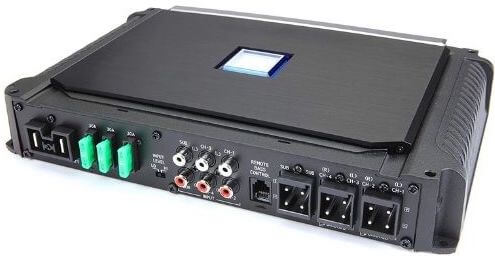
Specifications
Power (watts/ch) 4 Ohm 75W x 4 (Main channel), 300W x 1 (Subwoofer channel)
Power (watts/ch) 2 Ohm 100W x 4 (Main channel), 500W x 1 (Subwoofer channel)
Power (watts/ch) Bridged 4 Ohm 200W x 2 (Main channel), 2 Ohm 500W x 1 (Subwoofer channel)
Variable Low-Pass Filter 50-400Hz, -24dB/Octave
Variable High-Pass Filter 50Hz-400Hz -24dB/Octave Variable
Variable Bass Boost: 0 -12dB
Bass Boost 0-18dB (Subwoofer)
Bass Boost Frequency 50Hz (Subwoofer)
Subsonic Filter: 8-40Hz (Subwoofer)
Frequency Response 10Hz-60KHz (Ch 1-4) / 8Hz-400Hz. (Subwoofer)
Top-Side Control Panel
Built-in Crossover & Bass EQ
Signal-to-Noise Ratio: – > 105dB
Total Harmonic Distortion: 0.07%
Fuse Rating: 30A x 3
Pioneer GM-D9705 – Very Powerful 5-Channel Amp
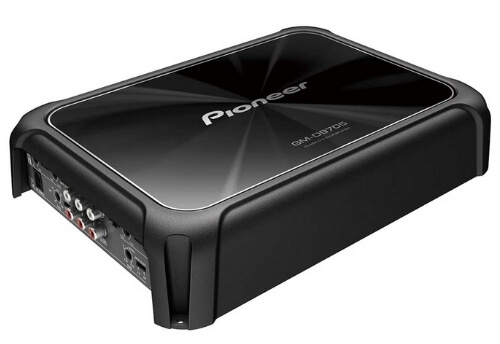
Pioneer is one of the most popular brands in the audio industry, and this amplifier cements the company’s place as one of the best.
The Pioneer GM-D9705 isn’t the cheapest, or most expensive, but the power it produces makes it a very affordable piece of equipment.
The amp uses Class D technology, which is important when delivering 75W x 4 speakers and 350W to your subwoofer channel all at 4 ohms, as it won’t need as much power to run.
The 4 main channels are bridgeable, so you can drive more power to less speakers if that’s your preferred set up. For example, you can bridge your main channels and run 200W x 2 RMS @ 4 Ohms bridged + 350W RMS @ 4 Ohms for your sub channel if you like.
The Signal-to-Noise Ratio (S/N) is greater than 94 dB, whereas the Total Harmonic Distortion (THD) is less than 0.005% on both the main channels and the subwoofer channel.
Added with the amplifier’s variable high pass crossovers allow up to a 500Hz cutoff frequency, and with its low pass crossovers it ensures this amp produces some powerful, clear and crisp music for any music taste.
Pioneer prides itself on its energy efficiency, but if you’d prefer to drive more power to the amp you can use larger gauge power wire as the power terminals support wire up to 4 gauge.
Speaking of the wiring terminals, this amp has some of the highest quality terminals, making installation easier than most car amps.
As well as the quality of the wiring terminals, the RCA inputs, crossover controls being on opposite side to the power and speaker wiring terminals, makes life much easier when installing or playing about with the wiring afterwards.
The wired remote for the bass is included in this amp package, so you don’t have to pay extra if you want it. Of course, this makes life much easier while trying to sculpt your own sound while driving.
Every amplifier on this list is of good quality, but what you get for the money this Pioneer GM-D9705 is hard to beat for power and efficiency.
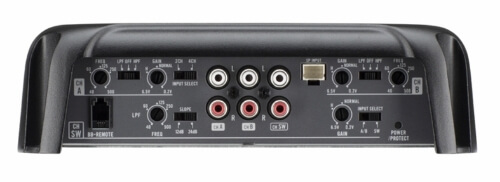
Specifications
Power (watts/ch) 4 Ohm 75W x 4 (Main channel), 350W x 1 (Subwoofer channel)
Power (watts/ch) 2 Ohm 100W x 4 (Main channel), 600W x 1 (Subwoofer channel)
Power (watts/ch) Bridged 4 Ohm 200W x 2 (Main channel), 350W x 1 (Subwoofer channel)
Power (watts/ch) 4 Ohm Mono Sub Ch – 150×1
Power (watts/ch) 2 Ohm Mono Sub Ch – 300×1
Frequency Response (Hz): A/B CH: 10 Hz ~ 50 kHz (+0dB, -3dB) / SUB CH: 10Hz ~ 500 Hz (+0dB, -3dB)
Low Pass Slope (dB/octave)-12dB/oct (A/B CH) / -12dB/-24dB (SUB CH)
Signal-to-Noise Ratio: – > 94dB
Total Harmonic Distortion: A/B CH: <0.05% (1kHz) / SUB CH: <0.05% (100Hz)
Active Crossover: – Amp 1-2: High Pass 500Hz, Sub Channel: Low Pass 40Hz
Fuse rating: 30A x 3
Bass Boost level: 0 dB to 18 dB
Hi-Volt Input Level Control200 mV to 6.5 V
Load Impedance Allowance: 2 to 4 ohms
Kenwood KAC-M8005 – Marine Grade 5-Channel Amplifier
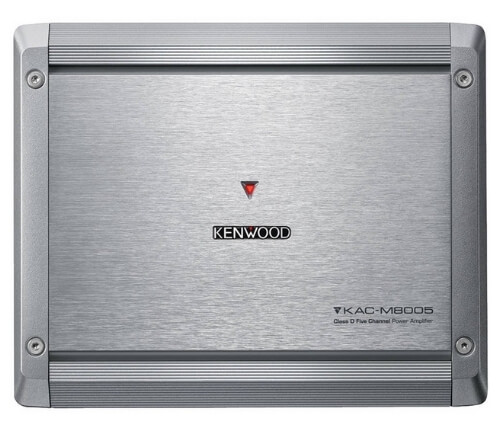
The next product on my list is the Kenwood’s KAC-M8005 5-channel power amplifier – a bridgeable Class D amplifier allows you to run a variety of set ups.
Coming with Extruded Aluminum Heat Sink Design this compact amplifier is perfect for anyone limited for space. Added with the amplifier’s conformal coating protection, it makes it a perfect amplifier for anyone with a boat.
The Class D technology and the products MOSFET digital switching power supplies, means this amp runs more efficiently than pretty much any other amp on my list, so again, those with a marine life, this could be the amplifier for you.
It’s not as powerful as some of the other amplifiers, but you can power your whole car stereo system, sending out 50W RMS x4 and 500W RMS to your subwoofer all @ 4 ohms.
It’s bridgeability allows you to make it into a 3-channel amp, giving you the option to run a set of high-powered component speakers 150W RMS x2 and a subwoofer @ 300W @ 4 ohms.
Using Kenwood’s bass boost and variable low-pass and high-pass filters, the amp produces wide frequencies, and at less than 1% the THD is impressive, but not the best on my list.
The 80 dB S/N is a bit average for the price, but don’t let that put you off, because the amp does produce some power to your set up, and will benefit any soundscape, no matter how big your vehicle, or how loud your boat is.
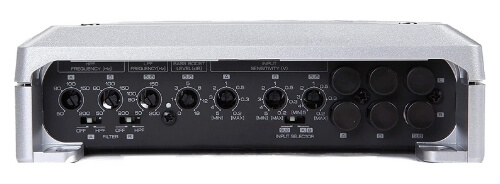
Specifications
Power (watts/ch) 4 Ohm 50W x 4 (Main channel), 300W x 1 (Subwoofer channel)
Power (watts/ch) 2 Ohm 75W x 4 (Main channel), 500W x 1 (Subwoofer channel)
Power (watts/ch) Bridged 4 Ohm 150W x 2 (Main channel), 300W x 1 (Subwoofer channel)
Frequency Response (Hz): 20Hz-50kHz (+0dB, -3dB) A/B; 20Hz-200Hz (+0dB, -3dB) SUB
Low Pass Filter 50Hz-200Hz, -24dB/oct (SUB)
Input Impedance 10k ohm
Speaker Impedance 4Ω (2Ω to 8Ω allowable)
Bridged Connection 4Ω to 8Ω allowable
Power MOSFET Switching Power Supply
Extruded Aluminum Heat Sink Design
High-Pass Filter 50Hz-200Hz, -12dB/oct (A/B)
Bass Boost 40Hz, 0dB – +18dB (SUB)
Signal-to-Noise Ratio: – > 80dB
Total Harmonic Distortion: A/B CH: <1% (+20kHz) / SUB CH: <0.5% (20-200Hz)
Planet Audio AC1800.5 Amp – 5-Channel Car Amp on a Budget
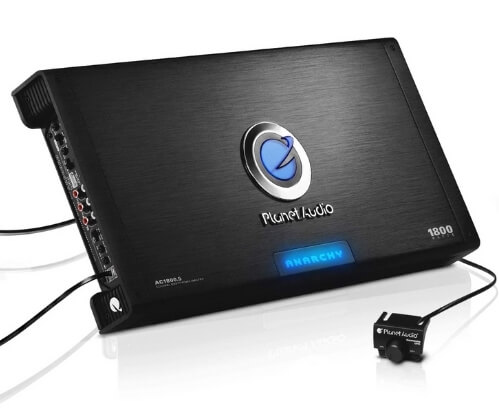
If you’re looking for the best 5-channel amp on a budget, this Planet Audio AC1800.5 amplifier will do exactly what you need it to and more.
This Class A/B flexible 2 to 8 Ohm Stable 5-Channel Amplifier will power your car stereo system producing impressive and clear volume for well under $200.
It benefits from the MOSFET power supply, which helps on power efficiency, which is needed for this powerful amplifier. You’ll be able to run 4 x 210W RMS @ 4 ohms, and your 5th channel 420W RMS @ 2 ohms.
Bridged it will allow you to run 2 x high-performance component speakers at 420W RMS @ 4 ohms and your subwoofer channel the same 420W RMS @ 2 ohms, which will allow for a powerfully loud and crisp full range soundscape.
The amp also benefits from its Variable Bass Boost (0 to +18 dB) feature, which allows you to control exactly how much bass you want to pump out to your subwoofer, while the Variable Low and High Pass Crossovers allow you to tweak the exact sound you’re after.
And with highly impressive S/N 102 dB and THD under 0.01%, it makes one wonder why anyone pays a few hundred dollars more for an amplifier.
At this price, however, there has to be drawbacks, and this amplifier lacks in the power terminals and fittings, which aren’t the highest of quality.
And although the amp is benefits from the heavy duty aluminum alloy heatsink, it needs it because this beast can get hot. This has been known to affect the protective system by cutting out, which could become a problem if you live in a hot climate.
For this price, however, you’re getting the best budget 5-channel amp on the market, and it will definitely improve your car stereo system. And if that isn’t enough, the remote bass boost comes with the package.
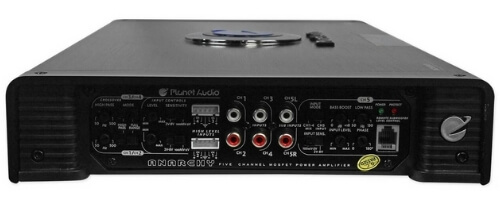
Specifications
Max Power 1800W
Power (watts/ch) 4 Ohm 210W x 4 (Main channel), 420W x 1 @ 4 Ohm (Subwoofer channel)
Power (watts/ch) Bridged 4 Ohm 420W x 2 (Main channel), 420W x 1 (Subwoofer channel)
Frequency Response (Hz): 20Hz-20kHz
Signal-to-Noise Ratio: – > 102dB
Total Harmonic Distortion: <1%
Input Sensitivity Selector
Variable Bass Boost (0 to +1 8dB)
Variable High Pass and Low Pass Crossover
Remote Bass Control Included
Hifonics BRX5016.5 Brutus 5-Channel Amp
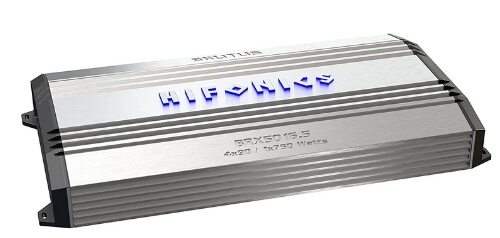
Hifonics are known for their elegant looking products and this BRX5016.5 Brutus 5-channel amp maintains its brand recognition. But don’t be fooled by the elegance, it’s really a beast in disguise that pushes some power to your entire system.
The amp benefits from dual speaker terminals, using Class A/B technology for your front and rear channels, while your subwoofer channel benefits from Class D.
This is arguably the best performing 5-channel amp for the price entry, with the RMS outperforming any other amp on my list. Running at 4 ohms you can push 4 X 60W on your main channels and 1 X 475W RMS on your sub channel. If you want to run your entire system at 2 ohms, however, you can push 4 X 100W and a fantastic 750W RMS for your subwoofer.
This amount of power requires the latest tech to keep it cool, and Hifonics utilises its ultra-fi MOSFET, which makes it run more efficiently, and helps negate sound distortion.
The subsonic filters also help with the power efficiency, and adds to the performance of this 5 channel amplifier, which provides the speakers with the perfect platform to perform at their very best.
The amp’s frequency range is 10Hz – 50 kHz, and the full high/low pass crossovers are available as well as a 0-18dB bass at 45Hz, while the S/N is over 90 bD, and the THD is under 0.05% ensuring you get a crisp clear soundscape even at the highest volumes.
And if you like your bass low, the amp benefits from the 45Hz Bass Boost – 0~18Db, which drives some powerful bass to your subwoofer. And with the subsonic filter, this amp really drives some power at all ranges.
This is the best performing car amplifier for the price, and although it’s a bit big it might not be suitable for those wight of space.
That said, the heavy duty aluminum alloy heat-sink with illuminated Hifonics logo exterior not only looks cool, but keeps it cool to help it perform for long periods of time.
My only concern with this amplifier is that it’s not bridgeable, although you can run it down to 1 Ohm if you need.
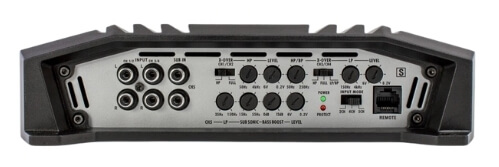
Specifications
Power (watts/ch) 4 Ohm 60W x 4 (Main channel), 475W x 1 (Subwoofer channel)
Power (watts/ch) 2 Ohm 100W x 4 (Main channel), 750W x 1 (Subwoofer channel)
Power (watts/ch) Bridged N/A
Ultra-Fi MOSFETS Circuit
Frequency Response (Hz): 10Hz-50KHz
Variable High Pass: CH1/2:50Hz-4KHz; CH3/4: 50Hz-250Hz
Variable Low Pass: CH3/4: 150Hz-4KHz; CH5: 35Hz-150Hz
Variable Subsonic Filter: 15Hz-55Hz
Heavy duty aluminum alloy heat-sink with illuminated Hifonics logo
High-Pass Filter 50Hz-200Hz, -12dB/oct (A/B)
Bass Boost 40Hz, 0dB – +18dB (SUB)
Signal-to-Noise Ratio: – > 90dB
Total Harmonic Distortion: <0.05%
Rockford Fosgate R2-750X5 – Very Efficient 5-Channel Amp
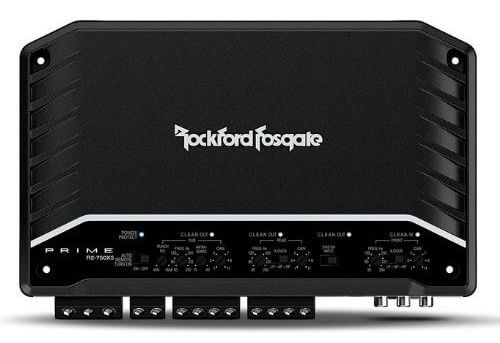
Rockford Fosgate is one of the biggest names in the car audio industry and this Prime Series – 750W R2-750X5 full-range, Class D amplifier cements its place on the top table.
Thanks to its Class D technology, which reduces the demand on your car’s electrical system, this powerful amplifier needs less power than most other amps to perform and your car will benefit from the amp’s efficiency.
Added with Rockford’s P.O.W.E.R. Supply circuit design, which allows the amplifier to generate even more “Dynamic Power’ as the voltage increases, this amplifier drives some crisp and dynamic power to your car stereo system, the harder it works.
Added with the C.L.E.A.N. circuitry that helps you easily adjust your settings, and Rockford’s Punch EQ technology that corrects itself anytime there’s a deficiency in sound, this 5-channel amp produces a full-range power that allows your speakers to push some crisp and clear volume from the lowest to the highest ranges.
Rockford Fosgate are well-known for producing more power than their specs claim, and thanks to the Dynamic Power generated from the P.O.W.E.R. supply this amp performs much higher than its stated specifications.
For example, the RMS is 50 Watts x 4 for the main channels, and 200 Watts x for the monoblock channel – all at @ 4Ω. However, with the P.O.W.E.R. supply this amp can push further reaching RMS 70 Watts x 4 and 241 Watts x 1 @ 4Ω.
You can run the amplifier at 2Ω and push 100 Watts x 4 and 350 Watts for the subwoofer channel, while the Dynamic Power will push it even further 114 Watts x 4 + 426 Watts x 1 – all @ 2Ω.
If Rockford’s Dynamic Power isn’t enough to convince you this 5-channel amplifier’s Front, Rear and Sub Variable Input Gain adjustment level gives you easier control over the output of this amp, and with the wired remote part of the package, you don’t have to spend more to get it.

Specifications
Power (watts/ch) 4 Ohm 50W x 4 (Main channel), 200W x 1 (Subwoofer channel)
Power (watts/ch) 2 Ohm 100W x 4 (Main channel), 350W x 1 (Subwoofer channel)
Power (watts/ch) Bridged 4 Ohm 200W x 2 (Main channel), N/A x 1 (Subwoofer channel)
Dynamic Power:
Power (watts/ch) 4 Ohm 70W x 4 (Main channel), 241W x 1 (Subwoofer channel)
Power (watts/ch) 2 Ohm 114W x 4 (Main channel), 426W x 1 (Subwoofer channel)
Power (watts/ch) Bridged 4 Ohm 234W x 2 (Main channel), N/A x 1 (Subwoofer channel)
Cast Aluminum Heat Sink
Frequency Response (Hz): 20Hz-20kHz
Includes RLC Remote Level Control
High and Low-Pass Filter 50 Hz – 250 Hz @ 12dB
Sub Infrasonic: 15 Hz – 40 Hz @ 12dB
Signal-to-Noise Ratio: N/A
Total Harmonic Distortion: A/B CH: <1%
BOSS Audio PV3700 – 5-Channel Amp
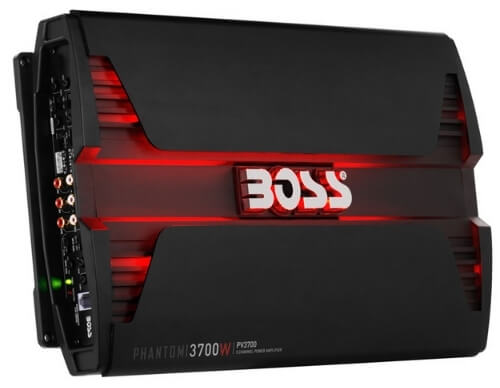
Boss Audio have delivered arguably their most competitive amplifier with this Phantom Series PV3700, High Output 5- Channel Full Range Amplifier, and it comes in at under $200.
Although max power isn’t a spec I use, Boss Audio’s claim of 3700W is impressive. That said, the RMS this beast powers is impressive too. Pushing 206W to the main 4 channels, and 750W to the subwoofer channel all at 4 ohms.
The amplifier is bridgeable, of course, and the amp is stable from 2 ohm to 8 ohm so there are many options available. For example, if you were to make it into a 3-channel amp running at 4 ohms, you could push an incredible 825W RMS x 2 to your main channels and 1500W to your bass channel.
All that power is going to generate some heat, especially as the main channels are A/B, but Boss Audio’s use of MOSFET Power Supply helps keep the amp powering with any slip in performance even on long drives. And there’s always Boss Audio’s Thermal Overload protecting it in case there’s any, erm overload.
With a Frequency Response of 9 Hz to 50 kHz, and the Bass Boost Variable from 0 to 18 dB it allows your speakers enough power to blast out a full range soundscape.
The amp also benefits from low and high pass filters to help with crisp and clear sounds at high volume. And if all the above isn’t enough, the Sound-to-Noise ratio of 103 dB is the best on my list, while the THD is, and I quote: 0.010000000000000000208%.
All in all, this is an impressive piece of equipment, and for the money I think it’s the best 5-channel amp.

Specifications
Power (watts/ch) 4 Ohm up to 206W x 4 (Main channel), up to 563W x 1 (Subwoofer channel)
Power (watts/ch) 2 Ohm up to 413W x 4 (Main channel), up to 1125W x 1 (Subwoofer channel)
Power (watts/ch) Bridged 4 Ohm 825 x 2 (Main channel)
MOSFET Power Supply
Frequency Response (Hz): 9 Hz to 50 kHz ±1 dB
Speaker Impedance 2-8 Ohm
Low-Pass Filter 50Hz-250Hz
High-Pass Filter 50Hz-250Hz
Bass Boost 40Hz, 0dB – +18dB (SUB)
Signal-to-Noise Ratio: – > 103dB
Total Harmonic Distortion: <0.010000000000000000208%
Soundstream RN5.2000D Rubicon Nano – A Great Factory Upgrade
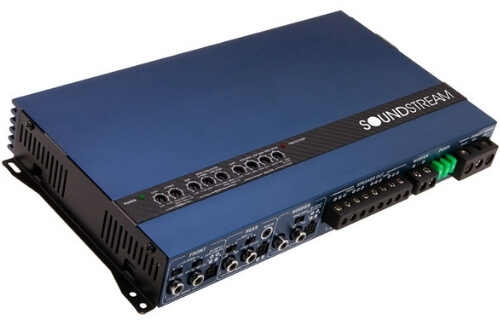
The next amplifier on our list is the Soundstream RN5.2000D 5- channel amp, which is part of the Rubicon Nano series.
Rubicon Nano series amplifiers are a big upgrade from Soundstream’s previous amps, and this powerful and efficient amplifier will drive some power to your car stereo system.
The improvements mainly come on the ease of use and installation, which the company has made its number one priority.
The main improvements to this Rubicon Nano are the signal inputs, power/ground, and speaker connections, which are all located to the leading edge of the chassis, making it much easier to install.
The pre-amp and crossover options are located on the top surface, making adjustments after installation easy too. And with subsonic filters 20Hz-50Hz and a bass boost 0-18dB to your sub channel ,the full-range it pushes makes it perfect for anyone upgrading their system.
Ease of use isn’t the only upgrade for this powerful and slick looking amplifier. Using Class D technology is a necessity for power efficiency because this amp blasts some power. And with MOSFET Power Supply, and the Hybrid Aluminum Alloy Heatsink helps maintain a steady performance, ensuring the amp never falters even during long drives.
At 4 Ohms the RMS is 75W x 4 to the main channels and an impressive 300W to the subwoofer channel. Of course, the amplifier is bridgeable, and running a bridged 3-channel amp can push a very impressive 200W x 2 to your main channels at 4 Ohms, and 500W x to your monoblock channel at 2 Ohms.
If any of the above information hasn’t won you over, maybe an S/N >104 dB, and THD <0.05% will. There are some negative reviews of the 5th channel lacking in power, which is regular for amps in this price range, but overall the reviews are very positive, and this amp is great for anyone looking to upgrade for the first time.

Specifications
Power (watts/ch) 4 Ohm 75W x 4 (Main channel), 300W x 1 (Subwoofer channel)
Power (watts/ch) 2 Ohm 100W x 4 (Main channel), 500W x 1 (Subwoofer channel)
Power (watts/ch) Bridged 4 Ohm 200W x 2 (Main channel), 2 Ohm 500W x 1 (Subwoofer channel)
MOSFET Power Supply w/ Audiophile Grade IRTM Transistors
Hybrid Aluminum Alloy Heatsink for Optimum Dissipation
Low-Pass Filter 50Hz-500Hz / (x10) 500Hz-5KHz
High-Pass Filter 50Hz-500Hz / (x10) 500Hz-5KHz
Bass Boost 0-18dB (Subwoofer)
Bass Boost Frequency 45Hz (Subwoofer)
Subsonic Filter 20Hz-50Hz (Subwoofer)
Frequency Response 10Hz-50KHz (Ch 1-4) / 10Hz-150Hz. (Subwoofer)
Signal-to-Noise Ratio: – > 104dB
Total Harmonic Distortion: <0.05%
Memphis 16-PRX5 5-Channel Amp – Full-Range 5-Channel Amp
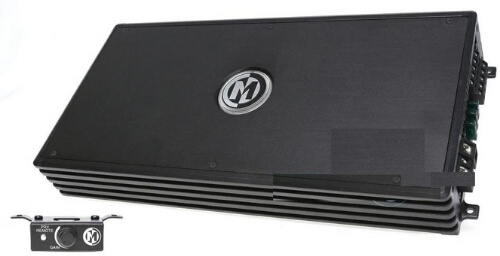
This 5-channel amp from Memphis is one of the best amps on the market, that offers great power to run a full-range car stereo system.
The amplifier is as powerful as one might expect from a high-quality Memphis amplifier. If you run all four main channels at 4 ohms you can push 50W per channel and 200W to the subwoofer channel.
If you run the main channels at 2 ohm, the amp will give you 75W x 4 RMS and 300W to your sub channel. The amp is bridgeable and this will allow you to push some high-powered component speakers up to 150W RMS.
For anyone looking for a full-range sound with extreme clarity at high volumes, this amp benefits from all the mod-cons you’d expect from a quality amplifier, including High Pass and Low Pass Filters, which ensure there’s no distortion as your music flips from highs to lows.
Speaking of lows, for those of you like your bass deep, this amp benefits from 0 – 12dB Bass Boost at 45Hz, and the Infrasonic Filter, both of which ensure the lows are as distortionless and loud as any amplifier on the market.
The amp uses High Current MOSFET Power Supply, which is always a bonus for any powerful amplifier. And for double protection, in case there’s any overheating the amp benefits from a Thermal, Short Circuit and Overload Protection ensures you don’t overdo it.
Another bonus for this amplifier is the Remote Level Control is included. This doesn’t win many over until they need it, and with most other amps it’s an extra cost, but not with the Memphis 16-PRX5.
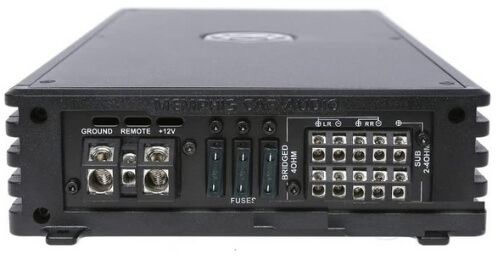
Specifications
Power (watts/ch) 4 Ohm 50W x 4 (Main channel), 200W x 1 (Subwoofer channel)
Power (watts/ch) 2 Ohm 75W x 4 (Main channel), 300W x 1 (Subwoofer channel)
Power (watts/ch) Bridged 4 Ohm 150W x 2 (Main channel) (Subwoofer Channel N/A)
High Current MOSFET Power Supply
Thermal, Short Circuit and Overload Protection
High Pass / Low Pass Filters
Variable Bass Boost: 0 -12dB
Bass Boost 0-12dB (Subwoofer)
Bass Boost Frequency 50Hz (Subwoofer)
Variable Infrasonic Filter (Subwoofer)
Frequency Response 20Hz – 20kHz
Signal-to-Noise Ratio: – > 105dB
Total Harmonic Distortion: <0.05%
Remote Level Control Included
Buyer’s Guide
Choosing The Right Amplifier For Your Car
An amplifier allows you to control and boost electrical signals to a much higher voltage, which is used to drive power to the speakers.
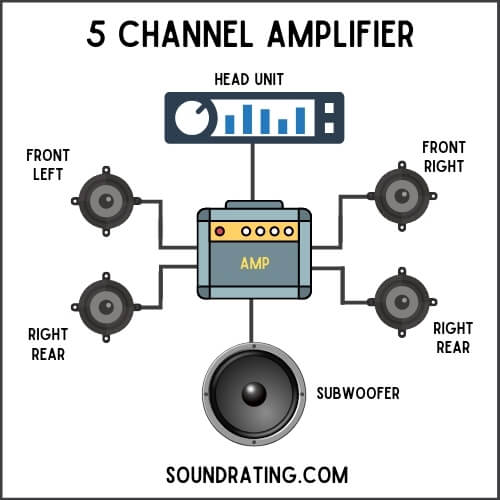
As you already know from having read the review and my Introduction To Car Amplifiers, car amplifiers come in all different channel sizes and drive different amounts of power.
And depending on your car stereo upgrade, will determine the sized amplifier you need. If you’re just wanting to power a subwoofer, a good quality monoblock amp will be perfect.
The output of amplifiers is measured in watts, where the power is split up into the channels. For example, a 1000 watt, five-channel amplifier will distribute power something like 4 x 100 watts to your four speakers and 600 watts to your subwoofer dedicated channel.
The subwoofer channel can have lower impedance than the main channels allowing you to run a subwoofer at 2 ohms, or even 1 ohm if necessary.
Types of 5-Channel Amps
Most modern car amps fall into one of two categories: Class A/B and Class D. They are specifically designed to output signals to drive your speakers, and both categories perform better at different things.
Most people will say Class D is the best and that might be true, in many cases, but some Class A/B amplifiers outperform Class D amps.
Some 5-channel amps utilize both classes, where the 4 main channels will utilize A/B technology while the D Class will be used to power the more energy intensive subwoofer channel. However, it all depends on the design of the amplifier.
Class A/B Amplifiers
A Class A/B amplifier is probably the most common amp because it’s been around for many years, and they are known for driving pristine power and clarity to speakers
Class A/B are a mix of the A Class and B Class, and take the best bits of technology from both classes. They are usually more expensive than Class D amps, and they also need more power from your battery.
However, they are well known for producing a more balanced soundscape, and are better for omitting distortion almost completely, and the best A/B amps will drive the very best midrange and treble reproduction you will hear.
Class D Amplifiers
Class-D is mostly used for monoblock amps thanks to their efficiency, lower temperatures and excellent bass reproduction. However, Class D is starting to be used more in multi-channel amps than before, especially 5-channel amps.
Class D is a newer and more efficient technology than A/B, and it is more durable and needs less power than other classes.
And thanks to the efficient way they drive electrical circuits to the speakers they run cooler than other amp classes. This is more necessary in monoblock amps because they’re used for subwoofers which require more power and generate more heat, and of course 5-channel amps come with an inbuilt monoblock amp.
What to Look for When Buying a 5 Channel Amp
Not all five-channel amplifiers are made the same. They all come with differing qualities, so you have to find one that matches your car stereo system and your musical taste.
This means you have to know exactly how much power output you need. It’s also worth knowing the the frequency response, the sensitivity it can drive at, if it’s bridgeable, and of course its Signal-to-Noise ratio (S/N), and the amp’s Total Harmonic Distortion (THD).
All of the above are important when out shopping for the best 5-channel amp, so for a closer look at what they mean read on…
Power Rating
When choosing the best 5-channel amp for you, the first thing to look for is the amp’s power rating. It should match your car stereo system’s power requirements.
All components of car audio come with a Peak Power Rating and an RMS Power Rating. The Peak Power is the power your device can work at in short bursts, whereas the RMS power is a continuous level of power it can comfortably work at.
Both power ratings are given in watts (W), but it’s fair to say you can ignore the Peak Power and only go with the RMS power.
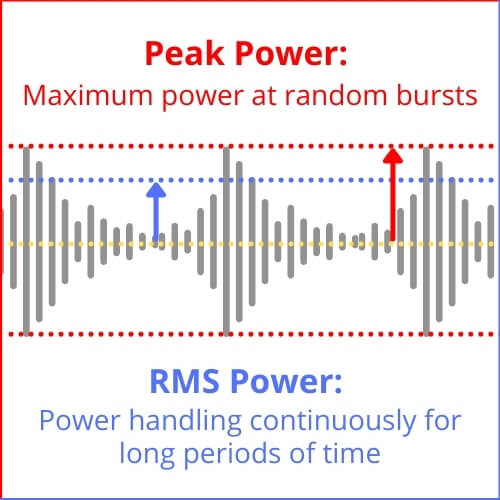
If you’re running 4 speakers and a subwoofer, you need to add up the total RMS of your system and at least match the RMS your amplifier can produce.
For example, if your four speakers are 75W each and your subwoofer is 300W, that means you’ll have to get an amplifier that has an RMS rating of at least 600W.
Keep in mind that it’s better to overpower than underpower your car speakers and subwoofer. If you underpower them, your speakers won’t produce the sounds you expect and could get damaged.
Therefore, look for the best 5-channel amp with an RMS rating that is higher than what your speakers and sub need.
If you’re getting a high-powered amp, make sure it comes with some sort of voltage or short protection so they don’t burn out. They can be annoying, but they can also save your expensive piece of equipment for burning out.
How Big Is The Amp’s Fuse
Manufacturers are known for putting specifications that don’t actually match the actual advertised specs. This is where the amp’s fuse comes into play. This is important because it will determine whether or not the amp can actually produce the continuous wattage RMS it advertises.
The formula for this is to multiple the watts by 2 then divide by the car battery.
For example, if an amp puts out 250 watts, you first multiple that by 2 – the numbers of watts coming in. Then you divide that by the car battery’s voltage, usually 14.4 volts. This gives you 35 amperage. If the amplifier does not use fuses with at least a 35 amperage rating, the amplifier will not be able to constantly push all 250 watts.
250 x 2 = 500 / 14.4 = 34.777: 35 amperage
Impedance Rating
Although it’s more important for your car speakers, another thing to consider is an amplifier’s impedance rating. Every amp comes with an impedance rating, which is given in ohms, which basically means how hard it has to work to deliver the power needed.
The lower the impedance rating, the easier it is for the amp to function, and the higher the impedance rating the harder it is for the amp to work.
5-channel amplifiers usually have either a 4 or 2-ohm (Ω) rating, and it’s important to know the impedance of your speakers before matching them with your amplifier.
Speakers and tweeters are nearly always rated at 4Ωs, whereas subwoofers are usually 2 Ωs. Most 5-channel amps will allow for 4-8 ohms for the main channels, whereas the subwoofer channel will be able to run 2 ohms and even 1 ohm in some cases.
The less ohms means it will require less power to produce the level of sound you needs, so getting a 2-ohm subwoofer channel
2-ohm impedance for a subwoofer will kick your sub into gear and ensure you get great sounding bass.
That’s not to say you can’t get 4-ohm subwoofers. Of course you can, but a 2-ohm sub will demand less power from your amp and will deliver louder bass than a 4 ohm equivalent, something that’s important when you’re running multiple channels.
Signal To Noise Ratio – S/N
Signal-to-noise ratio compares a level of signal power to a level of noise power, and it’s usually given in in decibles (dB).
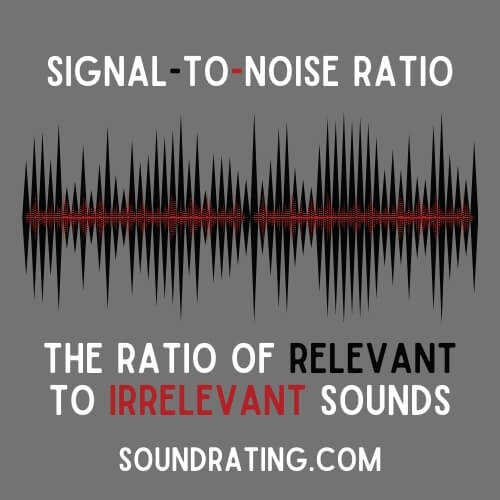
Higher S/N numbers mean a better and clearer sound, because there is more signal than noise. For example, if an amplifier S/N is 100 dB, it means that level of signal is 100 dB higher than the noise emanating from the buzz.
The actual noise is the electronic, vibrating hiss that humas away from every electrical device. If you turn your amp up full without any volume to your speakers, the hum will be quite apparent, and it’s this noise that has to be overcome by the signal, so the higher dB the signal, the better.
Total Harmonic Distortion – THD
Total Harmonic Distortion (THD) is another specification that’s important to know when shopping for the very best 5-channel amp.
THD compares input and output audio signals, with the difference in stages measured as a percentage, which represents the harmonic distortion or deviation of the output signal.
When an amplifier is driven with a signal, the signal at the output terminal of the amplifier is an amplified version of the input signal as well as any distortion created by the amplifier.
The levels of harmonic distortion in the best amplifiers are so far below audibility that they are basically of no concern. Anything below 1% is difficult to hear, and some of the best car amps have THD as low as 0.05%.
That said, your speakers and subwoofer can produce THD of up to 10%, no matter what your amp spec says, so to keep things crisp at loud volumes, you need to make sure your amplifier has the power capabilities to handle your car stereo system
Bridgeability
When looking for a good quality 5-channel amplifier you should consider whether it’s bridgeable or not.
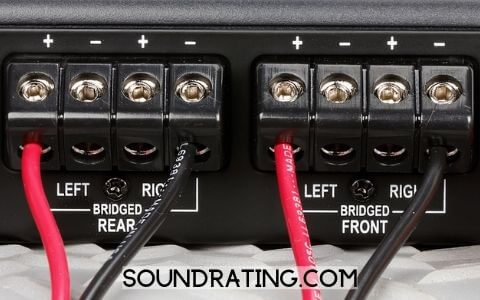
Bridging an amplifier is when you combine 2 channels into 1. It’s a very common thing to do because it allows you to double up the power value into each subwoofer or speaker and run more powerful high-performance speakers than you could from a single channel output.
Bridging allows you to be more flexible with your amp, which you might not need if you’re getting a 5-channel amp for four speakers and a subwoofer.
However, what if you change your speaker set up further down the line and want 2 subwoofers? If your amplifier isn’t bridgeable, you’d have to get another amp just to run your second subwoofer.
Whereas, if you get a bridgeable amp in the first place, you can always bridge your channels to power more than one speaker, freeing up a channel for that second subwoofer.
Fortunately, there are many bridgeable amplifiers on the market, so you don’t have to look too far. In fact most of my choices are bridgeable.
Does Size Matter?
When it comes to car amplifiers, size certainly does matter. But that doesn’t necessarily mean the bigger the amp, the more powerful it will be.
Your amp is going somewhere in your car, and of course space is limited, especially in smaller cars. And you have to consider if you’re getting a subwoofer, as well. If so, that will take up a fair bit of room.
Always know the space you have before buying a car amplifier. Make sure it fits, especially if you’re putting it under your car seat. You can get some great compact amplifiers, but remember it will get hot too, so buying one that uses heat dissipating technology is always a good idea.
Gadgetry
Controlling any device without moving far is always best, especially if you’re driving. Of course you can’t reach under your car seat and twiddle the knobs if it doesn’t sound right, at least not while you’re driving.
So, getting an amplifier that uses a remote control is always a good idea. An amp remote is a wired piece, which basically means there’s a way you can wire the amp to control parts of your stereo system from your seat.
Getting an amp with an adjustable equalizer will allow you to adjust the music more easily, too. It basically lets you tweak certain parts of the all-around sound to get it just how you like it.
Buying The Best 5-Channel Amp
As with everything in the car audio space, the best 5-channel amp has no definitive answer. Everybody is different and our tastes in music and everything else is unique to us.
And getting the best audio equipment means suiting it to our taste. Of course, there are many fantastic amplifiers on the market, all driving some crisp, powerful energy to your car stereo system, so looking around and doing some research is necessary. Especially when you’re paying a fe hundred dollars.
Don’t be fooled into the manufacturers promise, either, because many play on their Peak power rating, which always looks buyable. Any brand that emphasizes this mostly, has to be questioned.
And make sure you get the best wiring system for your amp. Most good amps will come with a full amp wiring kit, but make sure yours is the best you can get. If not, it’s worth investing a bit more for one, as they will help your amp perform at a much higher level.
Whichever product you choose to get, I hope I’ve helped you choose the best 5-channel amp for you.
5 Channel Amp FAQs
Why get a 5-channel amp?
Running 4 different speakers and a subwoofer ideally needs more than the commonly used 4-channel amps. Yes, you can power two speakers from one channel, but the power will unlikely be enough.
So, if you really want the best performance from your full car stereo set up, getting a 5-channel amp will ensure you get the best performance out of it.
How many speakers can a 5 channel amplifier power?
Even the best budget 5 channel amp can power four speakers and a subwoofer. You can also bridge two subwoofers and more speakers if you really want to, as long as you don’t overdo it with the RMS. You can also leave a channel empty if you find yourself not needing the fifth channel for some reason.
How many speakers can I run on a 5-channel amplifier?
A 5-channel amp gives you 4 channels dedicated to mid-range speakers, and one channel for a subwoofer. That said, you can run more or less speakers with it. For example, if you have some high-powered component speakers and you need more power you can bridge the channels and make your amp into a 3-channel amp. The main thing to remember is not to overdo the RMS, however many speakers your run from your amp.
Do you really need an amp for car speakers?
If you’re reading this: What’s The Best 5-channel Amp? article it probably means you need some power. And playing music at high volume without an amp, no matter what head unit set up you have will lead to distortion. If you can get them loud enough. Of course an amplifier amplifies sound and to get the crispest soundscape at high volumes you need a good car amplifier.
Where should I install my 5-channel amp?
The most common places are in your trunk or under your seat. It depends on the space you have available. If you have a subwoofer in the trunk, it’s a good idea to wire up your amplifier next to that.
Wherever you install it, plan with the routing the wires and make sure you have enough.

I am a passionate and skilled car audio enthusiast with 15 years of experience in the industry. My journey started when I replaced my first set of factory car speakers, sparking a deep love for high-quality sound. Since then, I have worked as a representative for renowned brands like Kenwood and Alpine.
With a background in both retail and distribution, I have developed a comprehensive understanding of the car audio market. Currently a certified (MECP) installer in the Mobile Electronics industry, my expertise lies in delivering top-notch audio installations. My knowledge, coupled with my genuine passion, makes me the go-to professional for all car audio needs.


Hi, I bought the Pioneer GM-D9705 after reading your review. It was working great at first, but for some reason it won’t turn on sometimes. I’ve checked the wiring, but can’t see any problems. Thanks in advance for the help and please keep the explanation simple as I’m a noob.
It’s more than likely going to be the wiring. Check the remote turn-on wire, which will be the blue and white wire from the back of the radio wiring harness to the amplifier. If it’s not that it will probably be the power or ground wire. Check them all to make sure they have a solid connection, and are crimped together securely. FOr more info on the remote wire, check this article out…